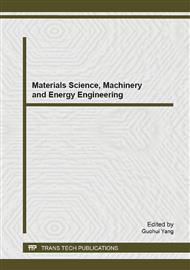[1]
D. Gao, J.K. Critser. Mechanisms of cryoinjury in living cells. ILAR journal, 2000, 41: 187-96.
DOI: 10.1093/ilar.41.4.187
Google Scholar
[2]
D.E. Pegg. The relevance of ice crystal formation for the cryopreservation of tissues and organs. Cryobiology, 2010, 60: S36-S44.
DOI: 10.1016/j.cryobiol.2010.02.003
Google Scholar
[3]
H. Kiani, D. -W. Sun. Water crystallization and its importance to freezing of foods: A review. Trends Food Sci. Technol, 2011, 22: 407-426.
DOI: 10.1016/j.tifs.2011.04.011
Google Scholar
[4]
R.M. Syamaladevi, K.N. Manahiloh, B. Muhunthan. Understanding the influence of state/phase transitions on ice recrystallization in Atlantic salmon (salmo salar) during frozen storage. Food Biophysics, 2012, 7: 57-71.
DOI: 10.1007/s11483-011-9243-y
Google Scholar
[5]
T.H. Yu, J. Liu, Y.X. Zhou. Selective freezing of target biological tissues after injection of solutions with specific thermal properties. Cryobiology, 2005, 50: 174-182.
DOI: 10.1016/j.cryobiol.2005.01.001
Google Scholar
[6]
A.A. Gage, J.G. Baust. Cryosurgery - a review of recent advances and current issues. Cryoletters, 2002, 23: 69-78.
Google Scholar
[7]
P. Mazur, S. Seki Survival of mouse oocytes after being cooled in a vitrification solution to-196°C at 95°C to 70, 000 °C /min and warmed at 610°C to 118, 000°C /min: A new paradigm for cryopreservation by vitrification. Cryobiology, 2011, 62 : 1-7.
DOI: 10.1016/j.cryobiol.2010.10.159
Google Scholar
[8]
S. Seki, P. Mazur. Ultra-rapid warming yields high survival of mouse oocytes cooled to -196°c in dilutions of a standard vitrification solution. PloS one, 2012, 7: e36058-e36058.
DOI: 10.1371/journal.pone.0036058
Google Scholar
[9]
K.R. Diller, E.G. Cravalho. A cryomicroscope for the study of freezing and thawing processes in biological cells. Cryobiology, 1970, 7: 191-199.
DOI: 10.1016/0011-2240(70)90021-0
Google Scholar
[10]
G.J. Schwartz, K.R. Diller. Design and fabrication of a simple, versatile cryomicroscopy stage. Cryobiology, 1982, l9: 529-538.
DOI: 10.1016/0011-2240(82)90182-1
Google Scholar
[11]
J.M. Hey, D.R. MacFarlane. Crystallization of ice in aqueous solutions of glycerol and dimethyl sulfoxide 2: Ice crystal growth kinetics. Cryobiology, 1998, 37: 119-130.
DOI: 10.1006/cryo.1998.2108
Google Scholar
[12]
J. Hey, D. Macfarlane. Crystallization of ice in aqueous solutions of glycerol and dimethyl sulfoxide. 1. A comparison of mechanisms. Cryobiology, 1996, 33: 205-216.
DOI: 10.1006/cryo.1996.0021
Google Scholar
[13]
J.M. Hey, D.R. MacFarlane. Kinetic analyses of crystallization and devitrification: Comparison of activation energies in aqueous solutions of glycerol and dimethyl sulphoxide. J. Non-cryst. Solids, 1997, 211: 262-70.
DOI: 10.1016/s0022-3093(96)00637-0
Google Scholar
[14]
V.L. Bronshteyn, P.L. Steponkus. Nucleation and growth of ice crystals in concentrated solutions of ethylene glycol. Cryobiology, 1995, 32: 1-22.
DOI: 10.1006/cryo.1995.1001
Google Scholar
[15]
G. Vigier, G. Thollet, R. Vassoille. Cubic and hexagonal ice formation in water-glycerol mixture (50% w/w). J. Cryst. Growth, 1987, 84: 309-315.
DOI: 10.1016/0022-0248(87)90146-1
Google Scholar
[16]
P.M. Mehl. Cryomicroscopy as a support technique for calorimetric measurements by dsc for the study of the kinetic parameters of crystallization in aqueous solutions: Part 1. Nucleation in the water—, 2-propanediol system. Thermochim. Acta, 1992, 203: 475-492.
DOI: 10.1016/0040-6031(92)85218-k
Google Scholar
[17]
P.M. Mehl. Crystallization in glass-forming aqueous solutions during warming: Umerical construction of non-isothermal dsc thermocurves during warming from isothermal data: Application to 42. 5% w/w 1, 2-propanediol/water. Thermochim. Acta, 1993, 223: 157-165.
DOI: 10.1016/0040-6031(93)80130-3
Google Scholar
[18]
P. Mehl. Isothermal and non-isothermal crystallization during warming in aqueous solutions of 1, 3-butanediol: Comparison of calorimetry and cryomicroscopy. Thermochim. Acta, 1989, 155: 187-202.
DOI: 10.1016/0040-6031(89)87145-x
Google Scholar
[19]
P.M. Mehl. Experimental dissection of devitrification in aqueous solutions of 1, 3-butanediol. Cryobiology, 1990, 27: 378-400.
DOI: 10.1016/0011-2240(90)90016-w
Google Scholar
[20]
G. Schmidt, M.M. Malwitz. Properties of polymer–nanoparticle composites. Curr. Opin. Colloid Interface Sci, 2003, 8: 103-108.
Google Scholar
[21]
B. Liu, S. Rong, Y. Zhou. Effect of ha nanoparticles on thermodynamic parameters of cryoprotective agents. Cryobiology, 2009, 59: 409-410.
DOI: 10.1016/j.cryobiol.2009.10.155
Google Scholar
[22]
X. Han, H.B. Ma, C. Wilson. Effects of nanoparticles on the nucleation and devitrification temperatures of polyol cryoprotectant solutions. Microfluidics and Nanofluidics, 2008, 4: 357-361.
DOI: 10.1007/s10404-007-0186-z
Google Scholar
[23]
T. Hagiwara, R.W. Hartel, S. Matsukawa. Relationship between recrystallization rate of ice crystals in sugar solutions and water mobility in freeze-concentrated matrix. Food Biophysics, 2006, 1: 74-82.
DOI: 10.1007/s11483-006-9009-0
Google Scholar
[24]
T. Gonda, T. Sei. The inhibitory growth mechanism of saccharides on the growth of ice crystals from aqueous solutions. Prog. Cryst. Growth Ch, 2005, 51: 70-80.
DOI: 10.1016/j.pcrysgrow.2005.10.005
Google Scholar
[25]
K. Muldrew, J. Rewcastle, B.J. Donnelly. Flounder antifreeze peptides increase the efficacy of cryosurgery. Cryobiology, 2001, 42: 182-189.
DOI: 10.1006/cryo.2001.2321
Google Scholar
[26]
G. Petzold, J.M. Aguilera. Ice morphology: Fundamentals and technological applications in foods. Food Biophysics, 2009, 4: 378-396.
DOI: 10.1007/s11483-009-9136-5
Google Scholar


